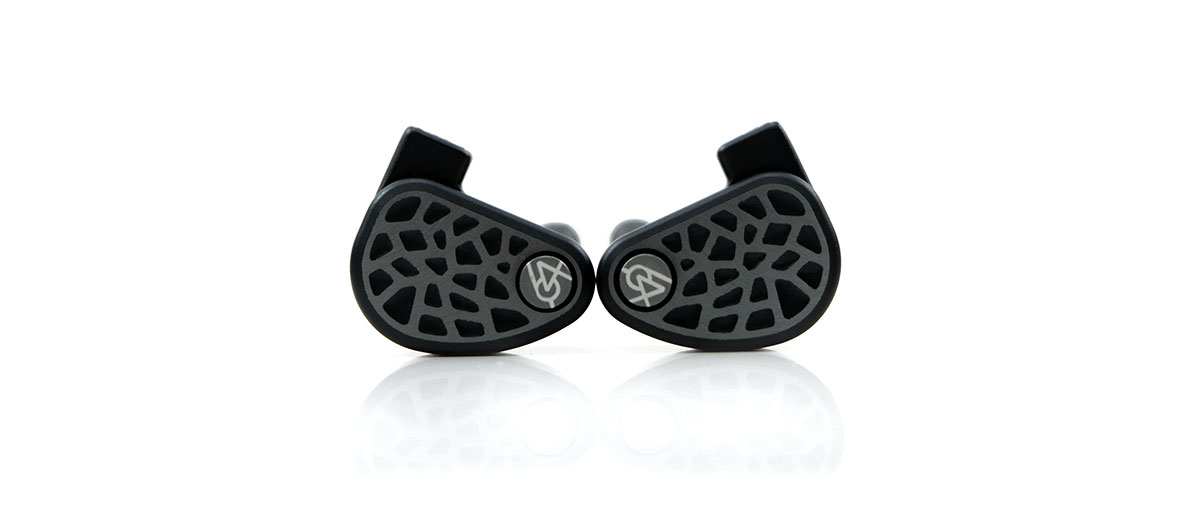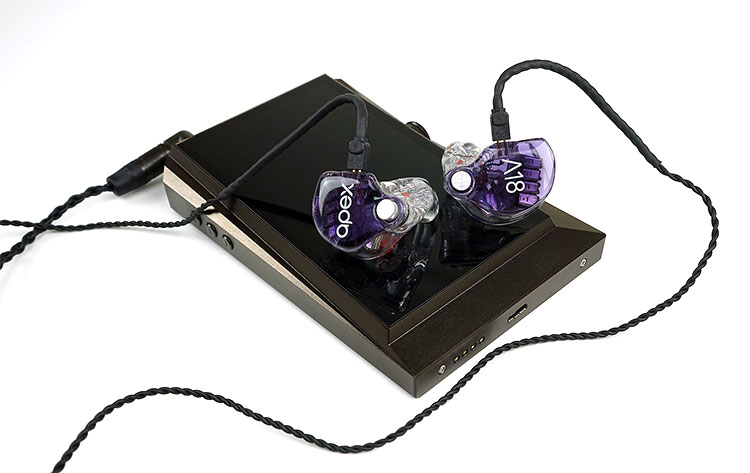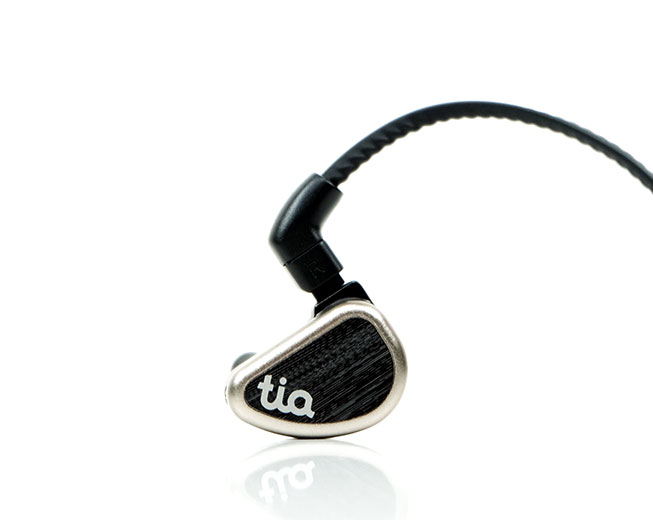Select Comparisons
64 Audio A18T
$2999
Technical
Although the A18T is a custom design it is still worth a comparison because it does have some tonal differences and I suspect the U18T would reflect similar differences also.
The A18T is designed more for critical listening than sound engineering through internally it has the same 18 BA driver configuration as the U18s. That means 8 BA for the lows, 8 for the mids, one for the mid-highs, and that tia driver for the highs.
Both use an integrated 4-way crossover for the driver groupings but I believe the crossover on the U18s has been changed since the original version with an electronic passive crossover network compared to a passive acoustical crossover inside the A18t.
Both monitors use the apex filtering system as well as tia technology for the tubeless high driver in the nozzle openings. However, the U18s also bring the latest LID flat impedance capability to the table where the A18T does not. I am actually surprised 64 Audio has opted not to introduce that into their T-line of monitors to this day so there must be some tuning reason for that.
In terms of efficiency, the Nio is rated at 6Ω and 105dB SPL compared to a very similar on paper spec from the U18s at 8Ω and 106dB SPL.
In our real-world testing with the LP P6, however, I did find the A18T to be a little more sensitive compared to the U18s by 2-3 clicks on its low-gain SE output. Neither have hiss issues from higher noise floors such as the HiBy R8‘s 4.4mm balanced output.
Design
One is a 3D printed exact custom design in acrylic and the other, the U18s, is a universal design milled from a CNC aerospace-grade aluminum billet, so quite different. However, I actually give the nod to the aesthetic of the U18s this time over the transparent clear shell and purple of the older A18T.
Granted, I am sure the 64 Audio 3D printed designs have come a long way since this initial 2016 3D print and the fit is way more accurate. However, there is something to be said about the sophistication and complexity of the new U18s faceplate as well as the overall durability of the aluminum shell.
Also, the custom design has flush 2-pin sockets compared to the U18s raised thick stems which some might prefer in terms of strength and ease of connection.
In the ear, the custom has the edge over the universal no question with the A18T being lighter and blocking out a very high level of background noise. The U18t does well but its slightly more unyielding aluminum lines and ear tips will not attenuate to the same level as a custom.
One final observation is the A18T’s more basic 48″ (or 64″) SPC 4-core Professional cable compared to the U18s better performing 8-core Silver cable as well as one less apex module, the mX module.
Performance
I think it probable that the A18t has some nuanced tuning differences to the U18t, at least judging some of the FR charts out there. However, the basic tenets of how it performs and differs from the U18s is largely the same, namely a stronger bass presence on the U18s as well as a more natural and relaxed treble tuning.
The A18t does seem to have a more forward 2-3k region with higher-pitching vocals and percussion further forward. They are generally more dominant in the presentation compared to the slightly warmer and more organic tones of the U18s.
I suspect a lot of that dominance comes from a low-end tuning that is more attenuated in the sub-bass compared to the U18s which has a stronger 20-100Hz elevation. This creates a more powerful bass fundamental and introduces that additional warmth into the midrange timbre of the U18s.
By contrast, the A18t has a punchy but lighter bass tone, even with the m20 module. You get less warmth up into the midrange and just a shade less body also with more treble influence creating a cleaner sound which, combined with that 2-3k elevation, creates a more vivid performance.
The U18s sounds smoother and more relaxed through the upper mids with a more forgiving approach to sibilance but no less resolving either. Both image beautifully, but what is emphasized in the staging is the key difference.
The U18s has the better power, the stronger fundamental and a bias to even over odd harmonics in its instrumental and vocal timbre. The A18t is brighter, leaner, and with more upper-mids and treble energy. To paint a metaphor, your head tilts upward with the A18t whereas it is straighter or on the level with the U18s.
64 Audio Nio
$1699
Technical
The Nio is actually a bit cheaper than the U18s but it might be seen by 64 Audio fans as a potential upgrade path so definitely worth a comparison. It does also have several similar in-house technologies and features as the U18s.
The Nio is a hybrid universal monitor comprising of a single 9mm dynamic driver, 6 BA for the mids, 1 BA for the high-mids, and one tia BA for the highs. The U18s also has a single BA for the mid-highs and a tia driver for the highs but has 8 BA for the mids and 8 BA for the lows. Both monitors use integrated 4-way passive crossovers.
The two monitors also share most of the 64 Audio in-house tech including all 3 apex filters with corresponding interchangeable sockets on the faceplates, as well as tia and LID impedance management technology.
The Nio also has a very low load rating at just 6Ω @1kHz but a moderate level of efficiency for SPL at 105dB. It is quite similar on paper to the U18s with its 8Ω impedance and 106dB SPL measurement.
Our testing found both monitors to play comfortably at similar volume levels using the SE output of the Lotoo PAW Gold Touch. Also, neither had any background hiss issues from sources such as the HiBy R8’s 4.4mm balanced output using the Premium Silver cable.
Design
Two thoroughly modern 64 Audio designs but two highly contrasting aesthetics with the Nio adorned with the natural blue abalone plate and chrome fenders and the U18s painting a darker complex milled CNC-aluminum gunmetal lattice design.
Both are very unique, very attractive but very different despite both having similar form factors. One thing to note is the slightly taller design of the U18s which you do not think would make a huge difference but you can feel it in the ear with the Nio having a snugger fit compared to the U18s.
The two monitors both offer faceplate sockets for the apex filter system and both come with the same lineup including an m20, m15, and an mX module. Both also use the 2-pin 0.78mm socket system at the rear on the protruding stems though the Nio comes with the lighter 4-core 48″ Premium cable and the U18s with the superior and better handling 8-core Silver cable.
Performance
Although I would class both monitors more to the smoother than the brighter side, they still do sound very different. In fact, with some test tracks such as heavy bass synth-laden Spaced by The Toxic Avenger, both monitors made the track sound completely different.
Low-end Delivery
The key for me for why one such track can be so different lies how much more low-end power and rhythm the Nio can generate from that dynamic driver compared to the more holographic, resolving, and airy delivery of the U18s.
No denying the Nio is the heavier-handed monitor so I suspect bassheads will just be fine with the excellent Nio bass delivery. However, as a point of comparison, it is somewhat slower-paced and denser compared to that quick decay and improved separation of the U18s BA drivers.
Going back to Space by The Toxic Avenger, moving from the U18 to the Nio was akin to someone slamming the brakes on a fast-moving car and entering ‘pimp cruise mode’. It was a huge change-up and for referencing purposes the Nio bass might not have quite the same finesse to pick apart in a studio compared to the U18s.
Yes, you do get more sustain, more texture in the Nio low-end and it does wonders if you want that strong sassy fundamental. However, if you need a little more clarity, more air, and a slightly less dominating low-end delivery that is more balanced with the mids then the U18s is the better choice.
Headroom & Timbre
The other big point of difference is the tuning for the mid-highs and highs. The U18s has more energy from 7-10K whereas the Nio starts to fade away from around 5k with less of an upper treble emphasis. You can easily pick out the better extension on the U18s, the superior treble presence, and improved resolution of fine detail over the relaxed Nio top-end.
That has the effect of stretching the sound stage a bit taller over the Nio and introducing more air and separation into a midrange that displays a more accurate instrumental and vocal timbre.
The Nio staging opts for enhanced depth and power, but it also means more warmth up into the mids. Combined with a more relaxed treble this creates a fuller sound but also a more rounded timbral tone with less odd-harmonic influence.
64 Audio tia Trió
$2299
Technical
The tia Trió was launched in 2019 and can be considered a closer relative to the tia Fourte than the U18s and sits just below the U18s in 64 Audio’s Audiophile monitor range.
The tia Trió is a triple hybrid driver configuration, as opposed to the U18s all-BA driver build, consisting of 1 tia high, 1 high-mid, 1 back-vented 10mm dynamic driver for the mids and lows. So quite a lot lower in terms of raw driver count but with a significantly different configuration with that FXC, (frequency eXtension Chamber), dynamic driver hybrid approach.
Like the U18s, the tia Trió also uses the apex filter system but unlike the U18s it is not interchangeable with a single m15 filter housed internally as opposed to the U18s external socket for the included mX, m20, and the m15 filters.
Both monitors do use tia technology with that tia high and both also use 64 Audio’s LID, (Linear Impedance Design), technology for better impedance management.
In terms of paper specifications, the tia Trió is rated at around 5Ω and 104dB SPL compared to the 8Ω and 106dB SPL of the U18s. In our real-world testing with the Lotoo PAW Gold Touch with both connected to the new Silver cable, I actually found the tia Trió to be slightly more sensitive to volume.
Though I can’t discount the possibility my perception of the relative volume level of the tia Trió is psychoacoustically shaped by the hard-hitting dynamic driver it does seem that the U18s need a bit more juice. Neither have background hiss issues going balanced with the Premium Silver cable using DAPs with higher noise floors such as the HiBy R8 4.4mm balanced output.
Design
The form factor of both is quite similar with the use of a 2-piece lightly curved aluminum alloy shell design though in terms of dimensions the U18s are bigger due to the larger driver count requiring more internal space. The nozzle is also a bit longer on the U18s so you might find a slightly deeper fit compared to the tia Trió.
I do think the design approach has evolved rapidly since the tia Trió offering, however. The milled CNC aerospace-grade aluminum faceplate design of the U18s shows a slightly deeper level of thinking behind universal faceplates and it is more eye-catching than the simpler tia Trio lightly brushed charcoal/black central faceplate design.
Both monitors have the reinforced rear 2-pin 0.78mm connector stems to the rear through to the front, the U18s lacks the venting port of the tia Trió since it does not use a dynamic driver. Interestingly, I actually do find the tia Trió to isolate just a little bit more than the U18s using the stock TrueFidelity tips on both and the m15 on the U18s.
One final note is the cable with the U18s using the superior Silver cable compared to the tia Trió which uses the standard black Premium cable. The standard Premium cable is a 4-wire 48″ detachable Silver-Plated Copper (SPC) cable as opposed to 8-wire SPC inside the Silver cable. The Silver is also less memory retentive and a bit quieter for microphonics.
Performance
This is actually quite an interesting matchup and some of the differences might come down to where your personal preferences lie despite the U18s having an edge on the technical side of the performance, especially through the lower mids.
Power
For the comparison, the U18s is using the m15 apex as the tia Trió has a fixed m15 inside also. Right away, the dynamic driver power can be heard, much like the Nio, however, in this case, it has slightly less warmth and more of a steeper dip into the lower mids.
The tia Trió curve is plenty powerful with a distinct sub-bass bias and a high contrast timbral tone creeping into the mids from a mid-treble 8k push that is more energetic and higher in amplitude compared to the U18s top-end curve.
The U18s has a gentler BA textured bass delivery with a smoother transition into the mids but also a smoother transition out of the mids into a fairly linear treble tuning. I would say the U18s bass is not light, at least not by BA standards but not as dominating as the slower decaying powerful rumble of the Trio bass.
Mids Delivery
Where the U18s really pulls ahead of the Trio is the quality of the mids. Now I personally love the musicality of the Trio mids with that forward vocal and energetic upper-mids percussion.
However, the lower mids have a bit of a dip that leaves instruments such as bass guitar plucks a little less distinct with the dynamic driver rumble and upper mids shine on either side overshadowing notes in this register.
The U18s renders lower-mids instruments beautifully with bass guitar plucks resonating very clearly and in their own space with excellent imaging. The dialing down of the bass levels also affords the U18s mids a bit more space so whilst they do not sound as energetic, they sound more complex and resolving compared to the tia Trió.
Treble is a bit more energetic from the tia Trió compared to the smooth tuning on the U18s. Again, there is a considered 8k peak that casts a little shine or odd-harmonic bias in the Trio’s more forward vocal and upper mids-presence. The U18s is a bit more relaxed sounding over the vocal ranges and not as forward. It has less bass/treble harmonic contrast and a slightly smoother tone.
Staging is also a bit different as a result. The tia Trió opts for a stronger top-end and low-end energy with a pushed vocal and percussion presence. Areas that fall in between are less distinct. The U18s is more balanced, more reference-like but also more open sounding and with better separation and imaging through the mids.
Overall
Overall, the tia Trió aims for the ‘tickle points’ as I call them for vivid listening, namely the sub-bass, vocal and upper mids presence, and treble clarity. The U18s offers something more balanced across the entire spectrum, better clarity in the mids, and a smoother listening experience to induce slightly less fatigue.
Our Verdict
The U18s is one of the most balanced offerings I have heard to date from 64 Audio. Nothing feels out of whack with a tuning that is effortlessly smooth, non-fatiguing yet every bit as resolving as the original A18t.
And importantly it is not a minor update or tweak on the A18t. This is unique, different, and for a different purpose also. I can listen to it this natural-sounding performance for hours, hear every bit of detail, and yet walk away without an ounce of fatigue. It is a far cry from the energetic, brighter, and more vivid tones of the A18t’s presentation.
And it’s a looker also. I was surprised in a very good way with what 64 Audio did with the U18s design. It will not seal quite as good as a heavily contoured acrylic competitor but it’s robust, durable, and very classy looking nevertheless.
There is a lot to explore with the U18s and I find myself using them more and more. Even just for casual listening, they seem the perfect travel companion with that apex filter system for cabinet pressure that tends to play havoc with my customs.
64 Audio U18s Specifications
- Driver Type/Count Eighteen precision balanced armature drivers
- Driver Configuration 1 tia high, 1 high-mid, 8 mid, 8 low
- Frequency Response 10Hz – 20kHz
- Sensitivity 106 dB/mW @ 1kHz @ 1mW (84mV)
- Impedance 8Ω Nominal
- Crossover Integrated 4-way passive crossover
- Isolation -20dB w/ m20 module, -15dB w/ m15 module, -10db w/ mX module






